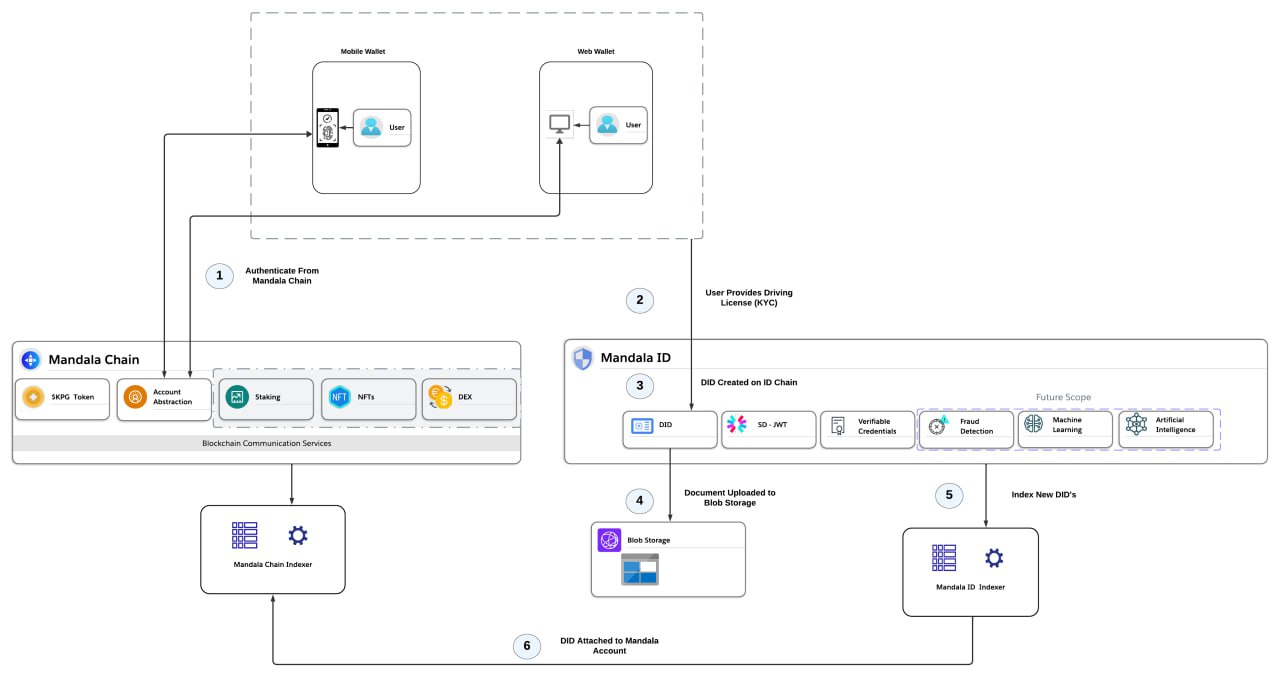What is MandalaID? Understanding the Technology
MandalaID is a blockchain-based framework specifically designed for creating and managing digital identities at national scale. At its technical core, it implements the W3C standards for Decentralized Identifiers (DIDs) and Verifiable Credentials (VCs) through a custom Substrate runtime module. A comprehensive Web3 framework that enables nations and organizations to deploy sovereign digital identity solutions while maintaining global interoperability. Built on Substrate technology and integrated with Mandala Chain’s EVM-compatible infrastructure, MandalaID provides a complete stack for creating, managing, and verifying decentralized identities (DIDs) and verifiable credentials (VCs).
The framework consists of three core components: a Substrate-based blockchain with the dedicated pallets for identity management, a modern administrative web application for credential issuance and management, and a GraphQL-powered indexer for efficient data querying. This architecture is planned to be deployed for Indonesia’s IDCHAIN, demonstrating its real-world viability.
The Three-Layer Architecture
- Blockchain Layer (Substrate Solochain) The foundation is a purpose-built blockchain using Substrate, Polkadot’s blockchain framework. It’s specifically optimized for identity operations through the pallet, which provides:
- DID Registry: On-chain storage and management of decentralized identifiers
- Schema Management: Dynamic credential templates with version control
- User Management: Identity lifecycle operations from creation to revocation
- Verification Methods: Cryptographic key management for authentication
- Administrative Layer (Next.js DApp) Government officials and authorized issuers interact with the blockchain through a sophisticated web application that provides:
- Multi-wallet Authentication: Support for Talisman, MetaMask, and Republik Passport wallet
- Visual Schema Builder: Drag-and-drop interface for creating credential templates
- Credential Issuance Workflow: Multi-step process for issuing verifiable credentials
- Real-time Blockchain Sync: Instant updates as transactions are confirmed
- Analytics Dashboard: Comprehensive metrics on DIDs, credentials, and system usage
- Data Layer (GraphQL Indexer) For efficient querying and analytics, the indexer processes blockchain events in real-time:
- Event Processing: Captures all 15 types of events (DID creation, schema updates, credential issuance, etc.)
- Relational Database: PostgreSQL storage with optimized indexes
- GraphQL API: Flexible querying interface for applications
- TypeORM Models: Strongly-typed data models for all blockchain entities
How DIDs Actually Work
When a person’s identity is created in MandalaID, the system generates a Decentralized Identifier that looks like this: did:mandala:a1b2c3d4e5f6.... This isn’t just a random string, it’s a cryptographically generated identifier that serves as the permanent anchor for all of that person’s credentials.

DID Creation Workflow
The DID Document stored on-chain contains critical identity information:
- Owner Account: The current controller of the digital identity who can authorize changes
- Creator Account: The original issuing authority (typically a government entity) that created the identity
- Identity State: Active, Inactive, or Pending status to manage the identity lifecycle
- Creation Timestamp: Immutable record of when the identity was first established
- Update Timestamp: Tracks the last modification for audit compliance
This structure ensures that every DID has clear ownership, a complete audit trail, and comprehensive status management. Each DID can hold multiple verification methods for different cryptographic operations such as authentication, assertion, key agreement, and capability delegation.
Verifiable Credentials: Beyond Paper Documents
MandalaID transforms traditional documents into Verifiable Credentials (VCs) that are cryptographically secure and instantly verifiable. The current implementation focuses on birth certificates as the foundational credential, establishing a person’s legal identity from birth.
Birth Certificate Credential Structure
A digital birth certificate in MandalaID contains comprehensive information that mirrors and enhances traditional paper certificates:
Core Identity Data: - W3C Credential Context: Ensures global standards compliance for international recognition
- Credential Types: Categorizes the document (e.g., “BirthCertificate”, “GovernmentIssuedID”)
- Unique Credential ID: A globally unique identifier for this specific credential
- Issuing Authority: The verified government entity that issued the certificate
- Issuance Date: Cryptographically timestamped date of digital certificate creation
Personal Information Secured on Blockchain:
- Subject’s DID: Links the credential to the person’s digital identity
- Given Name & Family Name: Legal names as registered at birth
- Birth Date & Place: Exact date and location of birth for legal verification
- Gender: As recorded on the original birth certificate
- Country Code: ISO standard country identifier for international recognition
- Registration Number: Unique government-issued number (blockchain-enforced uniqueness)
- Parent Information: Father’s and mother’s names for genealogical verification
- Hospital/Facility: Birth location for medical record correlation
- Registration Date: When the birth was officially registered with authorities
Cryptographic Security: - Digital Proof: Unforgeable cryptographic signature from the issuing authority
- Tamper Evidence: Any modification attempts are immediately detectable
- Instant Verification: Real-time validation against blockchain records
The system’s smart contracts ensure that registration numbers are unique across the entire blockchain network, making it impossible to create duplicate credentials or commit identity fraud. This provides a level of security that paper documents could never achieve.
Dynamic Schema System
One of MandalaID’s most powerful features is its dynamic schema system, which allows organizations to define custom credential types without modifying the blockchain code. Schemas support:
- Field Types: String, Number, Date, Boolean with validation rules
- Versioning: Semantic versioning with major/minor updates
- Field Limits: Up to 50 fields per schema
- Version History: Versions tracked per schema
- Status Management: Active/Inactive states for lifecycle control